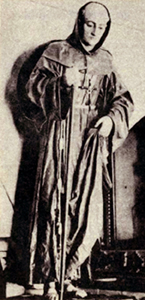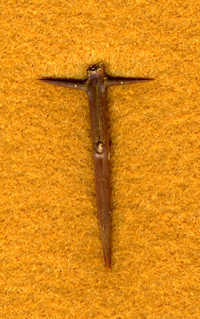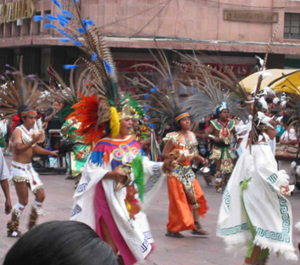 |
American History
Miracles of Fr. Margil:
The Tree of the Crosses
Margaret Galitzin

Ven. Antonio Margil |
As a native Texan, I was very pleased to see that devotion to Fr. Antonio Margil (1657-1726), one of the first missionaries to plant the seed of faith in Jesus Christ on Texan soil, is being spread. How is it possible that so few Americans have heard of this tireless Franciscan who was rightly called “a second St. Anthony of Padua” by his own Superior?
To your fine bibliographical page [click here] let me add this charming story about Fr. Margil and the miraculous Tree of the Crosses.
On March 11, 1697, Fr. Antonio Margil received the news that he had been elected Father Guardian of Holy Cross Monastery of Querétero, Mexico. Father Guardian, for those who don’t know, is the title for a Superior in a Franciscan house. He received this honor along with the order to leave immediately to take up the new charge. At the time he was laboring among the Indians in Guatemala. Without delay, he took to the road, and in only 14 days traveled the distance of 700 miles barefoot, and without a mule.
Thirteen years earlier when he had set out for mission work from Querétaro, he was already famous for his zealous preaching, love of penance and prayer, and gift of reading souls. Now, he had become a legend. The story had traveled back to Querétaro about the time when the fierce Talamanca Indians had cast Fr. Margil into a pile of burning wood, but the flames did not injure him although it blackened the image of the crucifix he held in his hands. Many persons gave accounts of how Fr. Margil would enter a village and go straight to the places in the mission churches where the witch doctors had hidden their idols, and then burn them in the public squares.

Thorns on the tree of the crosses. Below, a close-up of a thorn
 |
Eyewitness reports exist of soldiers who had accompanied the missionaries and returned to Querétaro telling how Mr. Margil’s feet did not get wet when he crossed streams or swollen rivers. One priest gave a sworn report of how Fr. Margil ate from a small bag of corn and shared it with other Indians of a village for three months without the corn ever running out.
Crowds of people were waiting in Querétaro to catch a glimpse of the humble Padre, toasted by the sun, with the poor mended habit, ragged sombrero, and the cord with a scull handing from his neck that he used when he preached.
Fr. Margil entered the Monastery, changed his ragged habit for a new one, and showed that he knew how to govern with the same zeal and prudence that he showed in his missionary work. He insisted on the exact observance of the Rule and customs of the Order. Every night, after praying the Divine Office, he used to make the Stations of the Cross in the Convent courtyard, and then took a harsh scourging.
On his return one day from preaching a mission in a nearby village, Fr. Margil stuck his walking cane on the ground in the garden of the courtyard adjoining the Monastery. Some days passed, and it was noticed that the cane had begun to sprout and grown into a tree. The miraculous tree produces no flower or fruit, but has a series of small thorns, each in the form of a cross. Each cross, in its turn, presents three smaller thorns that simulate the spikes of the crucifixion.
Persons have tried to plant cuttings from this tree in other places, but they will not grow anywhere else. The tree can still be seen in the monastery courtyard today.
The miraculous tree is a kind of metaphor of the lives of Fr. Margil and so many other early Franciscan missionaries who labored and offered everything for the conversion of the souls of the Indians. Their labors only took root because the missionaries were willing to take up and embrace the difficult crosses in their apostolate. The life of Fr. Antonio Margil was the cross, and only the cross.

Indians in Querétaro celebrating Aztec customs today |
The tree of the crosses also reminds us of Fr. Margil’s favorite devotion, the Stations of the Cross. On Fridays he would pray it in the streets, carrying a large cross, barefoot, with a rope around his neck and a rough crown of thorns on his head. Everywhere he went, he promoted the practice of the Way of the Cross. In Guatemala alone, he established more than 2,500 Ways of the Cross.
One can imagine the consternation and indignation of this grand missionary today when he witnesses from Heaven the Conciliar Church stimulating Indians to return to their idolatry under the pretext of preserving their “cultural values.” Also the Cross has being forgotten by the modern preachers, who only think about social actions and class struggle.
Fr. Margil gave his life and blood to abolish the idolatry of the infidel tribes. He sought to plant the seed of Faith and Christian Civilization, through the Cross. Today, almost everything is done in the opposite way.

Posted September 21, 2006

Related Topics of Interest
 Catholicism in Colonial America Catholicism in Colonial America
 La Conquistadora: Our Country's Oldest Madonna La Conquistadora: Our Country's Oldest Madonna
 Ven. Antonio Margil of Jesus: Apostle of New Spain and Texas Ven. Antonio Margil of Jesus: Apostle of New Spain and Texas
 Refuting the False Statements about Life in the Middle Ages Refuting the False Statements about Life in the Middle Ages
 Defending the Crusades Defending the Crusades
 The Swan's Song of Galileo's Myth The Swan's Song of Galileo's Myth

|
History | Home | Books | CDs | Search | Contact Us | Donate

© 2002- Tradition in Action, Inc. All Rights Reserved
|
 |
|